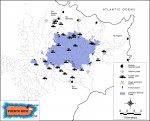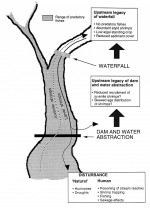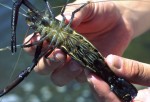The NSF LTER Program provides an important mechanism by which scientific data, collected within the 24-site LTER Network, can be used in resource management. A case in point involves science applications to water resource management in the Luquillo Experimental Forest (coterminous with the Caribbean National Forest) in the U.S. Commonwealth of Puerto Rico. The Luquillo Experimental Forest (~11,269 ha) is located in the highlands of northeastern Puerto Rico (Fig. 1) and serves as a key area for research, recreation, and tourism. It was declared a Biosphere Reserve in 1976 by UNESCO’s Man and the Biosphere Programme and designated as an LTER site by NSF in 1988. The forest receives an average of 4 m of annual rainfall and includes the upper portions of nine river basins.
There is increasing pressure on the Luquillo Experimental Forest to provide drinking water for human populations in the lowlands: at least 600,000 people are dependent on water withdrawn from rivers draining the forest. It was not until 1994 that a water-use budget was constructed for Luquillo (Naumann 1994). Creation of this water budget was facilitated by longterm discharge data available from 12 established stream gages located within or closely adjacent to the forest. The water budget indicated that on an average day, more than 50% of riverine water is diverted into municipal water supplies before it reaches the ocean (Naumann 1994). A total of 21 water intakes are operational within forest boundaries, and 9 large intakes are located in lower stream reaches outside the forest (Fig. 1). Many streams have no water below their intakes for much of the year and it is increasingly common for saline waters from the ocean to intrude 2-3 km upstream in the absence of riverine inputs of freshwater (Benstead et al. 1999). Conditions are particularly severe during drought periods and severe water rationing to local communities is common. Stream dewatering also results in less water to dilute wastewater discharged by sewage treatment plants into lower river reaches outside of the national forest (Fig. 1), and is an increasingly important constraint to tourism development in the coastal lowlands (Pringle and Scatena 1999).
The sheer magnitude of hydrologic changes being proposed for streams draining the forest has kept resource managers busy evaluating and providing scientific information relevant to poorly planned proposals (F. Scatena, USDA Forest Service, International Institute of Tropical Forestry, San Juan, Puerto Rico, personal communication). Conflicts for water usage between local communities and tourist complexes geared to off-island residents are aggravated by the fact that the dry season coincides with the tourist season. These conflicts can only be expected to increase as tourism expands. The island has recently experienced severe water shortages, despite its historical reputation as “the land of many rivers” (Pringle and Scatena 1999). In 1994, the drought became so severe that Puerto Rico was declared an agricultural disaster area by the federal government and water rationing was imposed in the major metropolitan area of the island.
Managers of the Caribbean National Forest and scientists from both the Forest Service and academia are concerned about the aforementioned water resource issue—particularly how effects of human disturbance are transmitted upstream and how they affect the biotic integrity of the national forest itself (e.g., Pringle 1997, Fig. 2). While the forest has some of the last undeveloped water supplies on the island, water withdrawals conflict with other functions that the forest fulfills (e.g., recreation, research, and the maintenance of the original biodiversity of the island). For example, because all of the fish and shrimp species (e.g., Fig. 3) that inhabit the streams of the Caribbean National Forest are migratory (i.e., traveling from stream headwaters to estuaries or the ocean and back at some point in their life cycle), dams, water abstraction, and pollution along stream continua can affect their populations (e.g., Holmquist et al. 1998). This can, in turn, have potentially important effects on ecosystem dynamics in headwater streams because research shows a strong linkage between species assemblages and ecosystem properties (Pringle 1996, Pringle et al. 1999, March 2000, Crowl et al. in press).
Scientists and managers have brought water resource issues facing the Luquillo Experimental Forest to both local and national attention. Projects funded by NSF and/or the USDA Forest at this LTER site include:
- Long-term monitoring of shrimp populations (e.g., Covich et al. 1996)
- Evaluation of in-stream flow and habitat requirements of shrimp (Scatena and Johnson in press) and fishes (N. Hemphill and E. Garcia, Caribbean National Forest, unpublished data)
- The timing of larval shrimp migration to estuaries (March et al. 1999)
- Estuarine shrimp larval development and upstream post-larval migration (Benstead et al. 2000)
- Effects of dams and water withdrawals on shrimp and fish mortality (Benstead et al. 1999)
- Genetics of shrimp populations between rivers (T. Crowl et al., Utah State University, unpublished data)
- Ongoing studies on effects of different types of water intakes on shrimp and fish mortality (J. March et al., University of Georgia, unpublished data)
- Ongoing studies on the impacts of water extraction and sewage releases on water quality in the Mameyes estuary (e.g., Scatena in press, and unpublished data)
Results of this research are being directly linked to management of hydrologic connections across the boundaries of the Caribbean National Forest. For example, Benstead et al. (1999) showed that water extraction over a two month period, from a major water intake located outside of the forest on the lower Espiritu Santo River (Fig. 2), resulted in high mortality (42%) of drifting first-stage shrimp larvae by entrainment during downstream migration. One hundred percent of drifting larvae were entrained by the intake during low flows when no water was discharged over the dam (Benstead et al. 1999). Field measurements of larval shrimp mortality, combined with a 30-year discharge record, were used to model the long-term impacts of different intake management strategies on shrimp mortality at the water intake. Results indicated that long-term mean daily entrainment mortality of shrimps ranged from 34 to 62%, depending on estimates of the water amount extracted from the river. A companion study on temporal patterns of shrimp migration (March et al. 1998), showed that larval shrimps drift during the night with a nocturnal peak occurring a few hours after dusk. This combined information was used to make recommendations for mitigation of negative environmental effects caused by water abstraction. Recommendations include:
- 3-5 hour stoppages in water abstraction during peak nocturnal (i.e. post-dusk) larval drift
- Up-keep of functional fish ladders
- Maintenance of minimum flows over dams
- Evaluation of different types of water withdrawal systems (March et al. 1998; Benstead et al. 1999).
As a result of these findings, the designs of two new water withdrawal systems have been altered by the Puerto Rican Aqueduct and Sewage Authority to minimize mortality of migrating aquatic biota. Intakes also operate when stream flows are high so that base flows are maintained. Equally encouraging is that water withdrawal from another intake on the Culebrinas River has been prohibited from 7 to 11 PM and a fish ladder has been required.
These small successes aside, what are the cumulative impacts of water withdrawals on the biotic integrity of streams and rivers draining the Caribbean National Forest (Fig. 3)? How will droughts and island-wide water shortages exacerbated by burgeoning human populations affect water withdrawals and the biological integrity of the forest in the long term? These are some of the questions that long-term research at the Luquillo LTER site will help address.
In summary, the Luquillo Experimental Forest (a.k.a. the Caribbean National Forest) is like many public lands throughout the U.S. in that it is increasingly threatened by human alteration of hydrologic connections outside of its boundaries. Expanding human populations require more water and they often look to public lands to meet their demands. On a global scale, humans have already appropriated half of the accessible freshwater runoff, and conservative estimates indicate that this appropriation could climb to 70% by the year 2025 (Postel et al. 1996). Correspondingly, there is less fresh water available for the environmental needs and integrity of ecosystems that are not dominated by humans. Of great concern are situations where hydrologic alterations outside of the boundaries of managed areas end up controlling the hydrology and/or biology of those areas. In a recent paper that just came out in a special issue of Ecological Applications devoted to the land-water interface and science for a sustainable biosphere( see references), the Luquillo Experimental Forest LTER site is provided as a case study, which highlights the critical need to address cumulative long-term effects of hydrologic alterations on public lands and to illustrate the synergism that can occur between field managers and scientists in implementing localized solutions.
References
Benstead, J. P., J. G. March, C. M. Pringle, and F. N. Scatena. 1999. Effects of a low-head dam and water abstraction on migratory tropical stream biota. Ecologi Applications 9:656-668.
Benstead, J. P., J. G. March, and C. M. Pringle. 2000. Estuarine larval development and upstream post-larval migration of freshwater shrimps in two tropical rivers of Puerto Rico. Biotropica 32 (3): 545-548.
Covich, A. P., T. A. Crowl, S. L. Johnson, and M. Pyron. 1996. Distribution and abundance of tropical freshwater shrimp along a stream corridor: response to disturbance. Biotropica 28:484-492.
Crowl, T. A., W. H. McDowell, A. P. Covich, and S. L. Johnson. In press. Freshwater shrimp effects on detrital processing and localized nutrient dynamics in a montane tropical rainforest stream. Ecology 00:00-00.
Holmquist, J. G., J. M. Schmidt-Gengenbach, and B. B. Yoshioka. 1998. High dams and marine-freshwater linkages: effects on native and introduced fauna in the Caribbean. Conservation Biology 12:621-630.
March, J. G., J. P. Benstead, C. M. Pringle, and F. N. Scatena. 1998. Migratory drift of larval amphidromous shrimps in two tropical streams, Puerto Rico. Freshwater Biology. 40:261-273.
March, J. G. 2000. The role of freshwater shrimps: patterns and processes along a tropical island stream continuum, Puerto Rico. Ph.D dissertation, Institute of Ecology, University of Georgia, Athens, GA 30602, 182 p.
Naumann, M. 1994. A water-use budget for the Caribbean National Forest of Puerto Rico. Special Report, U.S. Forest Service, Rio Piedras, Puerto Rico.
Postel, S. L., G. C. Dalily, and P. R. Ehrlich. 1996. Human appropriation of renewable freshwater. Science 271:785-788.
Pringle, C. M. 1996. Atyid shrimp (Decapoda: Atyidae) influence spatial heterogeneity of algal communities over different scales in tropical montane streams, Puerto Rico. Freshwater Biology 35:125-140.
Pringle, C. M. 1997. Exploring how disturbance is transmitted upstream: going against the flow. Journal of the North American Benthological Society 16:425-438.
Pringle, C. M. 2000. Threats to U.S. public lands from cumulative hydrologic alterations outside of their boundaries. Ecological Applications 10: 971-989.
Pringle, C. M. and F. N. Scatena. 1999. Freshwater resource development: Case studies from Puerto Rico and Costa Rica. Pages 114-121 in U. Hatch and M. E. Swisher, editors. Tropical managed ecosystems: The Mesoamerican experience. Oxford University Press, NY, USA.
Pringle, C. M., N. H. Hemphill, W. McDowell, A. Bednarek, and J. March. 1999. Linking species and ecosystems: Different biotic assemblages cause interstream differences in organic matter. Ecology 80:1860-1872.
Scatena, F. N. in press. Ecological rhythms and the management of humid tropical forests: Examples from the Caribbean National Forest, Puerto Rico. Forest Ecology and Management Special issue on New Directions in Tropical Forestry Research.
Scatena F.N., and S. L. Johnson. In press. Instream Flow Analysis for the Luquillo Experimental Forest, Puerto Rico: Methods and Analysis. USDA Forest Service Technical Report, Rio Piedras, PR.

 Enlarge this image
Enlarge this image

